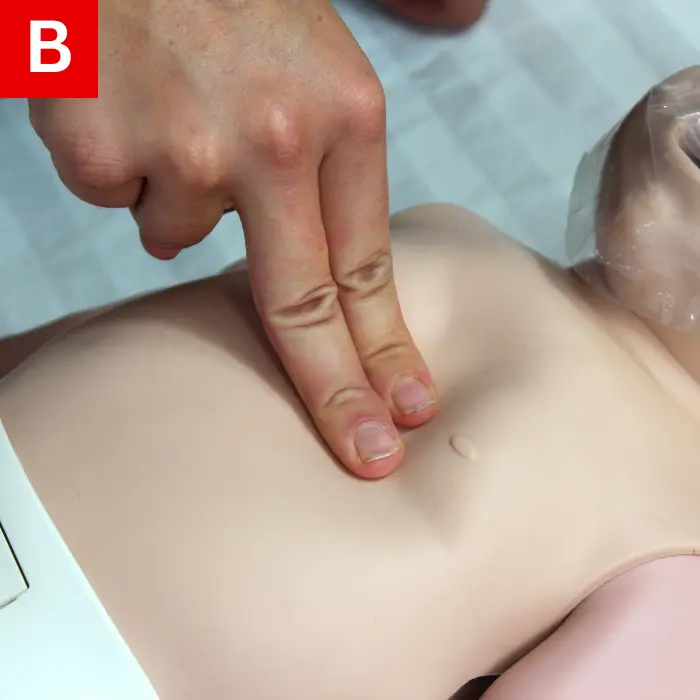Introduction to PALS
The Resuscitation Team
PALS Basic Life Support
- PALS Basic Life Support (BLS)
- BLS for Children (1 Year to Puberty)
- BLS for Infants (0 to 12 months)
- Pediatric BLS Algorithm
Pediatric Advanced Life Support
Resuscitation Tools
Respiratory Distress/Failure
Tachycardia
Cardiac Arrest
Pediatric Post-Resuscitation Care
PALS Essentials
PALS Skills Training
PALS Exam
BLS for Infants (0 to 12 months)
BLS for both children and infants is almost identical. For example, if two rescuers are available to perform CPR, the breath to compression ratio is 15:2 for both children and infants. The main differences between BLS for children and BLS for infants are (Table 2):
- Check the pulse in the infant using the brachial artery on the inside of the upper arm between the infant’s elbow and shoulder.
- During CPR, compressions can be performed on an infant using two fingers (with one rescuer) or with two thumb-encircling hands (if there are two rescuers and rescuer’s hands are big enough to go around the infant’s chest) (Figure 2).
- Compression depth should be one-third of the chest depth; for most infants, this is about 1.5 inches (4 cm).
- In infants, primary cardiac events are not common. Usually, cardiac arrest will be preceded by respiratory problems. Survival rates improve as you intervene with respiratory problems as early as possible. Keep in mind that prevention is the first step in the Pediatric Chain of Survival.
 Figure 2
Figure 2
ONE-RESCUER BLS FOR INFANTS
If you are alone with an infant, do the following:
- Tap the bottom of their foot and talk loudly to the infant to determine if they are responsive.
- If the infant does not respond, and they are not breathing (or if they are only gasping), yell for help. If someone responds, send the second person to call EMS and to get an AED.
- Assess if they are breathing while feeling for the infant’s femoral or brachial pulse for no more than 10 seconds (Figure 3a).
- If you cannot feel a pulse (or if you are unsure), begin CPR by doing 30 compressions followed by two breaths. If you can feel a pulse but the rate is less than 60 beats per minute, begin CPR. This rate is too slow for an infant. To perform CPR on an infant do the following (Figure 3b):
- Be sure the infant is face-up on a hard surface.
- Using two fingers, perform compressions in the center of the infant’s chest; do not press on the end of the sternum as this can cause injury to the infant.
- Compression depth should be about 1.5 inches (4 cm) and a rate of 100 to 120 per minute. - After performing CPR for about two minutes (usually about five cycles of 30 compressions and two breaths) if help has not arrived, call EMS while staying with the infant. The ILCOR emphasizes that cell phones are available everywhere now and most have a built-in speakerphone. Get an AED if you know where one is.
- Use and follow AED prompts when available while continuing CPR until EMS arrives or until the infant’s condition normalizes.

 Figure 3
Figure 3
TWO-RESCUER BLS FOR INFANTS
If you are not alone with the infant, do the following:
- Tap the bottom of their foot and talk loudly at the infant to determine if they are responsive.
- If the infant does not respond and is not breathing (or is only gasping), send the second rescuer to call 911 and get an AED.
- Assess if they are breathing while simultaneously feeling for the infant’s brachial pulse for 5 but no more than 10 seconds.
- If you cannot feel a pulse (or if you are unsure), begin CPR by doing 15 compressions followed by two breaths. If you can feel a pulse but the rate is less than 60 beats per minute, begin CPR. This rate is too slow for an infant.
- When the second rescuer returns, begin CPR by performing 15 compressions by one rescuer and two breaths by the second rescuer. If the second rescuer can fit their hands around the infant’s chest, perform CPR using the two thumb-encircling hands method. Do not press on the bottom end of the sternum as this can cause injury to the infant.
- Compressions should be approximately 1.5 inches (4 cm) deep and at a rate of 100 to 120 per minute.
- Use and follow AED prompts when available while continuing CPR until EMS arrives or until the infant’s condition normalizes.
